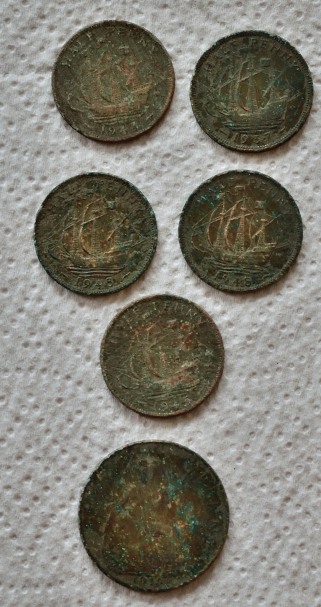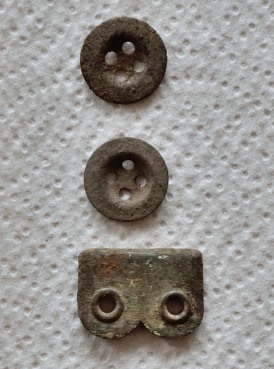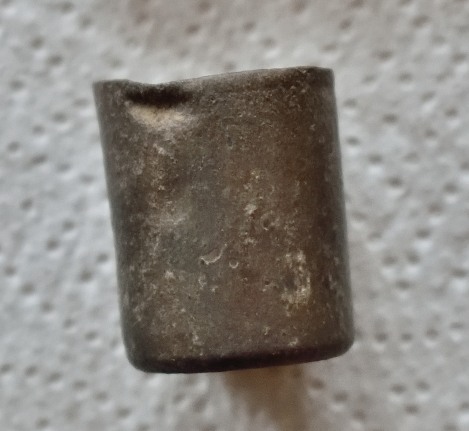When I first had the idea for WW2 Treasure Hunters and put pen to paper, I already had a number of sites and stories in mind. Indeed, the initial pitch contained 16 proposed locations and stories, which was then whittled down to eight that made it to the series as it was finally aired. Of those sites in the original pitch, all except 3 of them I already had permission to dig, which made life much easier for the production company.
One of those was the Royal Army Ordnance Corps depot near Loughborough. I hadn’t been digging the site long before the show got commissioned, but I had known of the location for some time, it being only a stones-throw from my house! Hence it was included in the pitch.
I have had some remarkable finds from this old base, and even after getting it detected by 15+ detectorists for the show, it is still producing excellent finds.
And today was no exception!
With a bit of spare time on my hands, I acquired the necessary permission from the landowner, then cleared it with the tenant farmer and the park gamekeeper. And today was the day.
It was rather cold with an icy wind blowing, but I’ve detected and dug in 12 inches of snow before, so this was in no way going to put me off. Plenty of layers makes you look like a Michelin man, but at least you’re warm.
The first hour passed quite quickly with not a single WW2 relic to my credit, just lots of lumps of lead and a coin spill of 5 ha’pennies. I switched locations by 50 yards to another patch of woodland I had detected three times previously, so I wasn’t hopeful there would be much left. However, as has happened to me in the past on different sites, I found a patch of land full of relics that I had somehow missed on every previous visit. There were a lot of dead stinging nettle stalks about, so I reasoned this is why I had avoided the area. Usually the stinging nettle clumps are the first place I search, as no-one else is daft enough to pitch into the middle of a forest of nipple high nettles. But this wood had been so productive, I hadn’t needed to.
There were still lots of bits of trash in there, but in among this trash some really nice WW2 relics. Two finds in particular were a first for me, and just showed what the RAOC guys were using to set off their explosives.





Some of the items you dig look and feel like junk, but it isn’t until you get them home and clean them that you realise they aren’t. Take, for example, these two padlocks. They could easily have been used for locking the RAOC stores doors, or even used with the kitbag locks, but without some sort of marking that shows they were army issue, you can never tell.
It’s still worth taking them home though, just in case. And in one case, damn good job I did!


Of course, with a RAOC depot, old ordnance is to be expected.



With the other personal stuff I was recovering, (old boot polish tins, toothpaste tins etc.), it was nice to get an item positively identifiable as being military.



And so on to the finds of the day.
The RAOC disposed of a lot of old ordnance at this site, processing some 30,000 tons of the stuff at the end of the war. They either recycled it, sent it away for salvage, sent it away to be blown up, (in a quarry in Wales), or, for the really dangerous stuff, blew it up on the park.
To set these explosions they needed fuzes, and I found a number of examples today.
Just a quick word on these items, in case you’re worried as to my safety! These items contain a small percussion cap in the base which is struck by the firing pin held in the body of the fuze. They are NOT a tube full of explosive!!!! They are just a little percussion cap which, when struck by the firing pin, sets off the detonator which is placed into the tube on the end as you set up the charge.
Just a reminder though that I’ve been digging WW2 relics for over 20 years and have built up a considerable knowledge. If you’re new to it and are ever unsure if what you’re digging is ‘safe’, LEAVE IT ALONE and call the authorities. No relic is worth a finger, hand, arm, leg or life.

I’ve never dug even one of the below items before, although I have seen plenty. Recovering WW2 relics is about safety, and knowing what you’re digging. Many people would have cast these aside as little bits of copper pipe, but they were identified the second they appeared……the hole and the crimps gave them away.
They are missing the detonator adapter, but are very nice examples. One has had tape wrapped round it, possibly to fix it to the items being blown up?

These were not affected by temperature like the No 10 chemical delay pencils.
They held a small piece of lead alloy wire, cut to a specific diameter. The wire was held under tension by a spring which, over a period of time, would cause enough stress in the wire to cause it to break. This released the firing pin which hit the small percussion cap in the base, which set off the detonator and explosive. The timer started from the moment you removed the safety pin, which went through the two holes at the top of the pencil.
A good day’s digging and not bad for only 2 hours of detecting!
Dear Stephen – from Peter Peters – my comments on this your page:-
Nettles grow best where there is phosphorus in the soil – I remember some of my colleagues had to dem some damaged phos grenades at Garendon but I forget the grenade number – could there be a connection?
Webbing strap ends belong to the small straps which went from the buckle on your 3 inch belt, over your shoulder and back down to the belt buckle so to support the weight of ammo pouches attached thereto which were each big enough to hold 3 loaded Bren gun mags or several hundred rounds of SAA in boxes or clips.
I distinctly remember the brass padlock was used to secure the A-in-U stores in which was a stencil cutting machine and a mass of discarded X-ray films from Loughborough General Hostpital and silver nitrate crystals all to stencil codes on brass cases 3.7 in AA HE fuzed 208.before transport to CAD as Serviceable.
The vast dem site in North Wales was in fact No. 1 EDU RAOC Trawsfynydd where the craters were on top of Mynydd Bach and the concrete firing bunker was only half a mile away on lower ground. Seven craters each packed with 11 tons net of HE were sequentially detonated – what bangs! – the ground shock tickled our feet seconds before the air wave flattened the grass and my hearing was defected for ever.
There’s more if you want to know – kind regards – Peter
LikeLike
Certainly do want to hear more! 🙂 🙂
LikeLike
Traws – as we called it was an amazing and in a srange way both an exciting and satisfying experience. particularly drying our soaking waterproofs by watching from 300yd thirty tons of cordite bags go up in a white flame.
We had a good laugh though at the Sub-Conductor’s pet corgi which took its morning run by escorting the motor convoy of ammo out of the compound but then running the straight line up the mountain whilst the convoy zig-zagged its way round several hairpin bends at speed to get to the top where we saw the cogi somewhat breathless but looking triumphant.
LikeLike
I trained using time pencils at School of Ammo CAD Bramley- they where deemed to be unreliable so your pals and the instructor stood behind the blast wall while you pulled the pin.
LikeLike
LOL! And here’s me thinking the L-delay ones were the safest of them all to use!
LikeLike
Some alloys were known to be prone to inter-granular corrosion – hence the rumour.
The zinc alloy used to make Fuzes Mine Contact No. 2 was particularly sensitive and an accidental explosion of these fuzes at Saxelby Lab killed three members of the Royal Pioneer Corps and injured others. Acting Staff Sergeant K.W.Nash was decorated for recovering the dying and injured from among a litter of live damaged fuzes
LikeLike
So do you know if they changed the alloy in the No 3 fuzes then, in light of this?
LikeLike
The 9L time pencils went up to MarkV! so may well have had the alloy adjusted.
The Fuzes Mine Contact ( No.2 I think) had bodies made of Mazak – an alloy of almost pure zinc hardened by a tiny addition of copper (hence the inter granular corrosion in the presence of an infinitessimal amount of water). Corrosion destroyed the structure of the alloy and allowed the spring to push the safety pin through the mush until the striker rested on the cap – drop the box and as the french say POUF! I must say I never heard even a low explosive go POUF – BANG is better onomatopoea.
LikeLike
These are No. 3 fuzes, and thanks for the info on how they became unstable. Very interesting 🙂
LikeLike
Thanks for the correction – No. 3 it was – I must get it right even if I have not handled them for 70 years – thank goodness!
Which led me to remember how I survived potential catastrophies – damaged always fuze on 3in smoothbore HE (for Smith gun), burning 3in rocket motors that got loose, vandal deployed trip-wire bounding anti personnel mine (for drop to resistance forces), rain of splinters from dem of heavy shells HE and a jet in the eye of hot paint fragments from colliding 9in howitzer shells while handling, a violent RTC with 3tons of 36M grenades on board showering down from a little Bedford artic(I wasn’t driving and the grens were not primed, at least as far as my sample only inspection told me). Did you know that the explosive charge in 36M’s was Baratol a mixture of TNT and the very heavy barium nitrate to make the grenade’s weight match the throwing power of cricketers. Clever Sir William Mills!
Trophies which happened my way did lighten the day but unhappily were long ago recycled – base of 5.25 QF cart with interesting head stamps, beautiful clockwork mechanism from fuze 208, coloured smoke generators, signal rockets, silk parachutes (2in mortar flares), 303 ball Mk8Z or perhaps MkVIIIZ( can’t remember) but I did raise my squad’s average when shooting for the Corps at Bisley by persuading the storeman to issue me with Mk8Zs, they were more powerful and precise than Mk7 and originally intended for use in the Bren gun (my general attitude to mechanical design wa inspired by that weapon). I won a competition in my school JTC team by stripping down the gun and reassembling in 45 seconds- Ready to Fire SIR!
LikeLike
Futher to mine about Fuzes Mine Contct No.3 I remember being told by the SIOO Capt Bertie Cull that the fuze became obsolete after my 100% inspection and disposal and a new fuze was designed for AT mines.
I cleared thousands of mines from storrage on the estate of His Grace The Duke of Rutland, some were new but some had been de-fuzed and returned from the beaches, good old RE’s!
LikeLike
How interesting. I bet the Duke of Rutland was rather pleased to see the back of them.
LikeLike
Yes and His Grace’s gamekeeper turned a blind eye to our removal of 360 rabbits from under the mine stillage and taking them to a butcher shop in Melton Mobray where we got 1/3p each for them
LikeLike
LOL!
LikeLike
We really must meet up again one day and have a proper chat! Some amazing stories there Peter. And as for the 45 seconds……WOW! 🙂 🙂
LikeLike